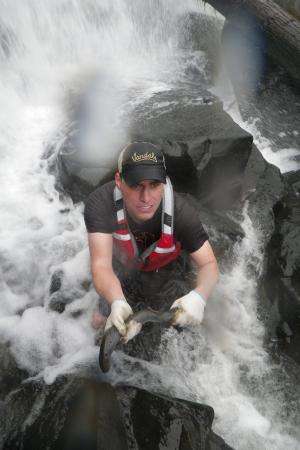Sampling at Willamette Falls
A new study aimed at understanding habitat needs for Pacific lamprey in western Oregon found this once-abundant fish that is both ecologically and culturally significant prefers side channels and other lower water velocity habitats in streams.
However, because of the legacy of historic land uses in the Northwest – including human settlement and activities – these habitats are much less common than they were in the past. And that may explain why populations of lamprey have declined over the past several decades – not only in western Oregon, but throughout the Pacific Northwest.
Results of the study were just published in the Ecology of Freshwater Fish.
"The lamprey decline has probably been going on for the past half century, but it wasn't until the last 15-20 years that it has been recognized by many in the scientific community," said Luke Schultz, a research assistant in Oregon State University's Department of Fisheries and Wildlife and lead author on the study. "Today lamprey populations are at about 5 to 10 percent of the 1960s totals at Bonneville Dam, and the story is much the same elsewhere.
"The Willamette River basin is one of the few places that still appears to have decent numbers of lamprey because of its system of sloughs and side channels," he added. "But they are facing new threats, such as introduced fish species that prey on them – especially bass – so we'll likely be hearing more about this emerging threat in the next few years."
Schultz is project leader Oregon Cooperative Fish Research Unit's Pacific lamprey project – a joint effort between OSU and the U.S. Geological Survey that is seeking to learn more about the fish and restore its habitat. Although this latest article focuses on the Willamette Basin, Schultz and his colleagues at OSU, the USGS, Oregon Department of Fish and Wildlife and the U.S. Fish and Wildlife Service have looked at lamprey populations and habitat from the Columbia River in northeastern Oregon to southern Oregon's Umpqua River.
The causes of Pacific lamprey decline are myriad, the researchers say. Restoring their numbers will require mitigation in the form of restoring habitat to include complex channels and deep pools, and the removal of barriers that block access to spawning grounds for adult lampreys, the authors note.
"Removal or mitigation will allow lampreys to recolonize those areas," Schultz said.
Some factors affecting the lamprey decline may be out of the researchers' control, Schultz said, specifically ocean conditions. They require an abundance of food; ocean conditions that are favorable to salmon are usually beneficial for lampreys, as well. Rather than swimming freely, they may attach themselves to large fishes, or even whales, sea lions or other marine animals – and the abundant ocean prey lets them grow large.
"Pacific lamprey may spend one or two years in the ocean," Schultz noted. "They will weigh less than an ounce when they go out there as juveniles, and they may grow to 30 inches in length and up to two pounds before they return."
Although Pacific lampreys are anadromous, another species, the brook lamprey, only grows to a length of 6-7 inches and stays in fresh water for its entire lifespan of 4-8 years.
It is the Pacific lamprey that researchers are focusing on because of their one-time abundance, larger size, and more prominent ecological role.
"These are really interesting animals that have historic importance in the Pacific Northwest," Schultz noted. "They can live up to about 10 years or so – about three times longer than the coho salmon life cycle – and they are roughly six times as energy-dense as salmon, making them important prey.
"Because of that, I like to call them swimming sticks of butter."
When lampreys are abundant, they reduce predation by a variety of species – especially sea lions, but also sturgeon, birds, bass and walleye – on juvenile salmon and steelhead. It may not be an accident that salmonid numbers have declined at the same time lamprey populations have diminished.
The research in the study has led to some habitat restoration work supported by the Columbia River Inter-Tribal Fish Commission. Helping lamprey populations recover has important social significance as well as ecological importance, Schultz said.
"Lampreys were an incredibly important resource for many Northwest tribes because they provided a source of protein in the summer months when salmon weren't as readily available," he noted. "Now the only place where there is even a limited tribal harvest is at Willamette Falls."
Provided by Oregon State University























